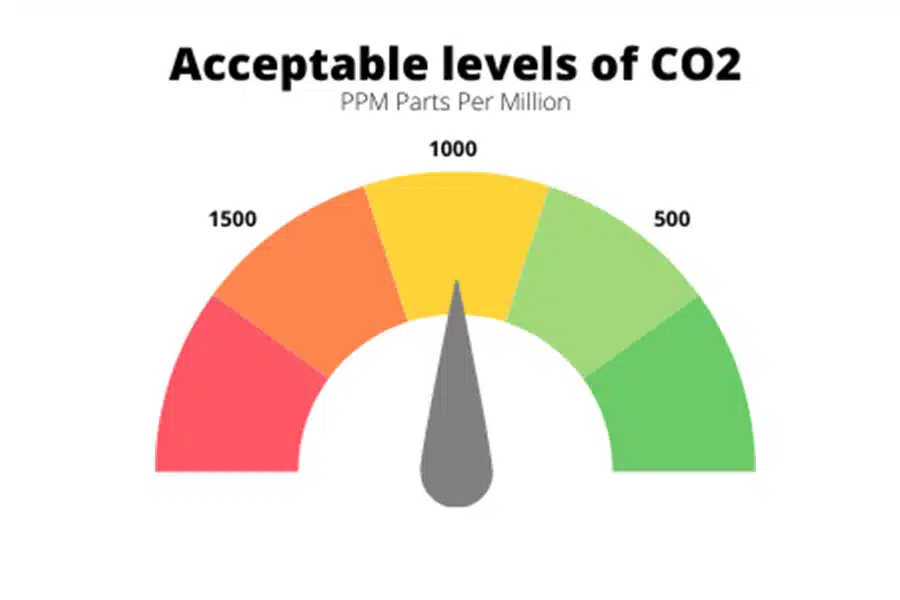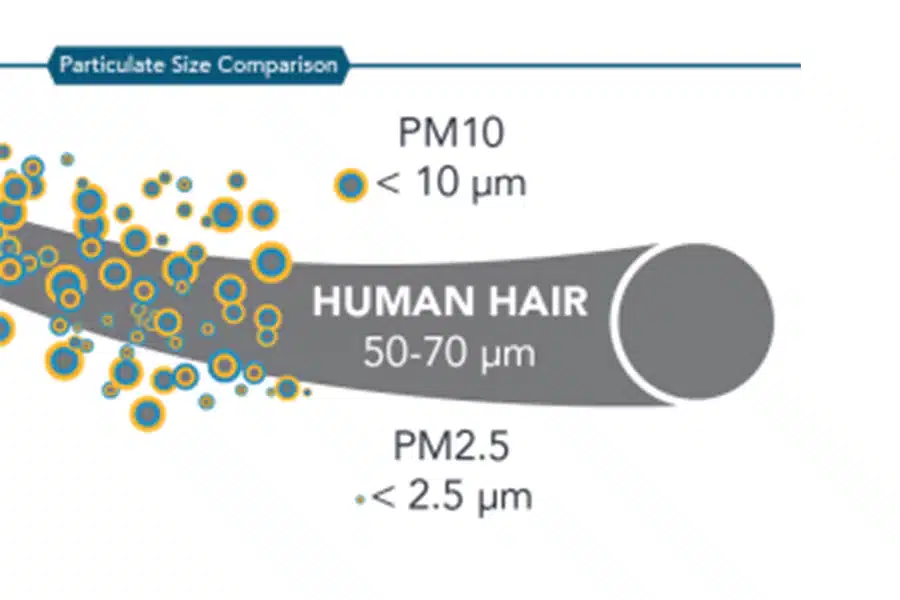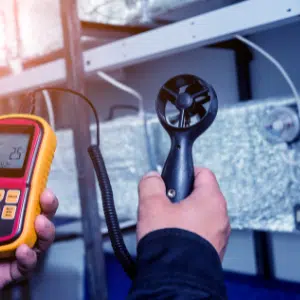What is Indoor Air Quality?
Indoor Air Quality (IAQ) covers a variety of different gasses, particles and compounds that are almost invisible to the human eye yet circulate through your workplace every day. The main Indoor Air Quality indicators include carbon dioxide (CO2), volatile organic compounds (VOC) and Fine Particulate Matter (PM).
Carbon dioxide (CO2) is an invisible gas found naturally occurring in the air. It is also produced by human exhalation. Generally, carbon dioxide can be found at levels around 400 to 500 PPM (parts-per-million) in the atmosphere. Studies show as carbon dioxide levels rise above 1000 PPM, numerous health issues including headaches, fatigue, tiredness, nausea, dizziness and restlessness. As the levels rise into the 1,000’s, these symptoms become worse including severe headaches, high blood pressure and breathing difficulties. This can end up in hospitalization and debilitating long-term health conditions.

Volatile Organic Compounds (VOCs) are gasses emitted from either solids or liquids within your workspace. This can include paint, aerosol sprays, cleaners and disinfectants, timber furniture preservatives and office equipment such as photocopiers, inks, glues and permanent markers. Signs and symptoms of exposure to unhealthy levels of VOCs include eye, nose and throat irritation, and allergic reactions including skin rash, headaches, dizziness, fatigue and nausea.
Fine Particulate Matter (PM) covers a wide variety of tiny particles invisible to the eye. They are measured in microns with 2.5 PM particles being 2.5 microns or less and 10 PM being 10 microns or less. 2.5 PM particles are included in the 10 PM particle count for overall PM measurement. To give context, the width of a 2.5 PM particle would be approximately 30 times smaller than a piece of human hair. These tiny particles or droplets can include dust, smoke, pollen, mould spores and virus and bacteria particles. Exposure to high daily levels of Fine Particulate Matter can adversely affect the health of your workspace as the particles this size are small enough to travel deeply into your lungs and embed themselves throughout your respiratory system. Common effects of high concentrations of PM particles include bronchitis, and asthma attacks, and studies have linked 2.5 PM exposure to respiratory and cardiovascular disease including increased hospital visits and even death.

What happens if Indoor Air Quality is ignored?
These symptoms and health effects can be severe if Indoor Air Quality is ignored. A recent paper written by SAHMRI in South Australia has linked a significant increase in airborne transmission of viruses such as cold, and flu, including COVID-19 with high levels of CO2. Utilizing fresh air intake, they were able to show a reduction in CO2 and also in the spread of these viruses in Aged Care situations. For a business, the loss of production, increased sick days, Sick Building Syndrome and medical expenses can cost thousands if a permanent solution is not identified and put in place.
How do we measure Indoor Air Quality?
The first step is to measure the Indoor Air Quality within the space and identify areas such as office cubicles, meeting or lunch rooms that are high in CO2, VOCs or PM particles. This is done using a highly sensitive IAQ meter that will take a sample of air over a 30-minute period and average the quantities of Carbon Dioxide, Volatile Organic Compounds and Fine Particulate Matter. Once the measurements are taken an assessment can be made. Quite often there is existing infrastructure that can be utilised to increase fresh air intake and improve filtration like the existing air conditioning systems and exhaust fans. If not, there may need to be additional fresh air ducts, filters or air scrubbers installed, including the use of Lossnay fresh air systems, to ensure the correct levels of fresh air are achieved. For VOC and PM particles, free-standing air purifiers are often a good option in rooms that cannot be easily filtered using the existing air conditioning systems. Such areas include dental or doctor consulting rooms, small offices and lunch rooms.

What happens if you get this right?
Once the Indoor Air Quality is maintained at good levels in a workplace we often see an increase in productivity, a reduction in sick days and a drop in sickness including cold, flu and other viruses spreading throughout the workplace. Once problematic areas are identified and preventative measures are in place, there is little maintenance required to maintain a great workplace environment with good Indoor Air Quality.

How can you get your workplace tested?
If you are interested in getting your workplace tested, T&K Airpower can help. We have a range of airflow and Indoor Air Quality measurement tools that will allow us to accurately measure and determine if your Indoor Air Quality is within acceptable ranges and identify problematic areas. We have a wide range of products and solutions to suit most budgets which allows quick rectification of Indoor Air Quality problems. Complete the below form and we will get in touch to discuss the options available.

